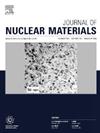Investigating the interactions between hydrotalcite and U(IV) nanoparticulates
Abstract
In the UK, the decommissioning of legacy spent fuel storage facilities at the Sellafield nuclear facility requires the retrieval of radioactive sludge resulting from Magnox fuel corrosion. However, sludge retrievals may enhance uranium mobility including via sorption of radionuclide nanoparticles onto colloidal phases such as hydrotalcite (Mg4Al2(OH)16(CO3).4H2O). Hydrotalcite is a Mg-Al layered double hydroxide (LDH) which is a corrosion product of Magnox fuel cladding. Currently, there are a paucity of studies examining interactions between actinide nanoparticles and LDH phases such as hydrotalcite. Here, a multi-technique approach was used to investigate the interactions between colloidal hydrotalcite and three different forms of nanoparticulate U(IV): nanoparticulate uraninite (UO2); nanoparticulate UO2 reacted with silica (UO2-Si); and U(IV)-Si-coprecipitate under anoxic, neutral-to-alkaline conditions. Ultrafiltration and zeta potential analyses indicated that for UO2 and UO2-Si nanoparticulate phases, sorption to colloidal hydrotalcite was limited due to rapidly settling UO2 and UO2-Si aggregates (>450 nm). By contrast, ultrafiltration and zeta potential analyses confirmed the U(IV)-Si-coprecipitate nanoparticle phase showed significantly higher sorption to colloidal hydrotalcite. This was due to the increased colloidal stability of intrinsic U(IV)-silicate nanoparticles which in turn promoted increased sorption to hydrotalcite. TEM imaging showed some evidence for smaller UO2 and UO2-Si aggregates (<20 nm) sorbed to colloidal hydrotalcite. Similar behaviour was observed in TEM images of authentic pond effluent samples from Sellafield, providing confidence that the model laboratory experiments provided a bridge to the highly radioactive spent nuclear fuel pond interactions. This study highlights the potential for U(IV) nanoparticles to form a new type of colloid-colloid interaction with hydrotalcite, especially when silica is present. This further informs predictions of U(IV) (and An(IV)) behaviour in the legacy pond and silo environments, as well as in environmental scenarios where LDH mineral phases and silica are present (e.g. in geological disposal of radioactive waste).

 求助内容:
求助内容: 应助结果提醒方式:
应助结果提醒方式:


